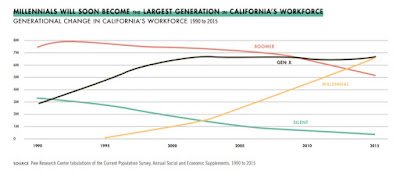By C.J. Hirschfield
It’s public: After 17 years at
the helm of Children’s Fairyland, I will be stepping out of my ruby slippers,
hanging up my big wings and finding out what other magical adventures await me
beyond our beloved park. And I am not alone. Over just the
past few months, four other executive directors of high-performing local
nonprofits have announced their departures.
Get ready, because there will be
a wave of Baby Boomer retirements from the nonprofit sector, representing a
remarkable opportunity for younger—and more diverse—leaders to rise.
 |
| "Welcome to your staff meeting!" C.J. Hirschfield and team in a 2005 photo |
First, a little bit of context. Of
the nonprofits currently in existence, 90 percent were created since 1950. Most
cause-related nonprofits (that is, other than arts, higher education, health or
sciences) were founded in the 1960s. Many of us were inspired by the
politically active times in which we came of age, and poured our passions into
work for wonderful causes. But nonprofits often fall short when it comes to
taking care of themselves—in grooming the next generation of executive leaders.
I learned this—and quite a lot
more—at a retreat I attended in advance of my announcement. “What’s Next:
Leading a Thriving Transition” is presented by TSNE
MissionWorks, whose purpose is “to prepare leaders and their organizations
for the transition ahead by providing frameworks, tools and an opportunity to
plan; to develop a sense of community and a network for ongoing learning and
support.” The retreat provided me with what I needed my board of directors to
know so we could do everything possible to ensure an effective transition in leadership.
I highly recommend the program.
The Boomer exodus was expected
some years ago, but during the tougher economic times of the last decade, “late
career” leaders decided to stay in their organizations longer. The anticipated
pipeline became a bottleneck instead—for a time. But the exodus is coming.
Today’s workforce is more diverse
in age than ever before; Millennials are projected to make up nearly 75 percent
of the workforce by 2025. California communities are more diverse by race and
ethnicity than a generation ago, but this diversity is not yet reflected in the
executive and board leadership of the nonprofit arts sector, according to a
2016 report by the William and Flora Hewlett Foundation that focuses on
arts organizations. I think those findings can be extrapolated to apply across
the sector.
The study noted that emerging
leaders, with higher levels of education and more student debt, will have
elevated expectations for taking on roles with real influence, a desire for
rapid career advancement, and concurrent salary expectations. Many of us
Boomers entered the nonprofit world happily accepting long hours and low pay; it’s
doubtful that the next generation of leaders will do the same.
How can we use the Boomer exodus
to better publicize opportunities, build mentorship programs, and identify
emerging leaders of color? And here’s another question: Will emerging leaders
in the for-profit sector, and particularly the tech sector, who may be frustrated
by the lack of meaning or community in their current position, be willing to
take a pay cut and retirement benefits to go the nonprofit route? I did, but my
rent was not in the stratosphere, and my student debt was manageable. I doubt
that today’s younger workers would—or could—make the same choice.
It’s time to make the changes
that will help nonprofit organizations stay healthy enough to continue doing
the critically important work they do.
__
C.J. Hirschfield has served for 17 years as executive director of Children’s Fairyland, where she is charged with the overall operation of the nation’s oldest storybook theme park.


No comments:
Post a Comment
Note: Only a member of this blog may post a comment.